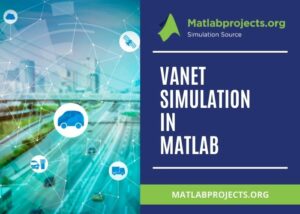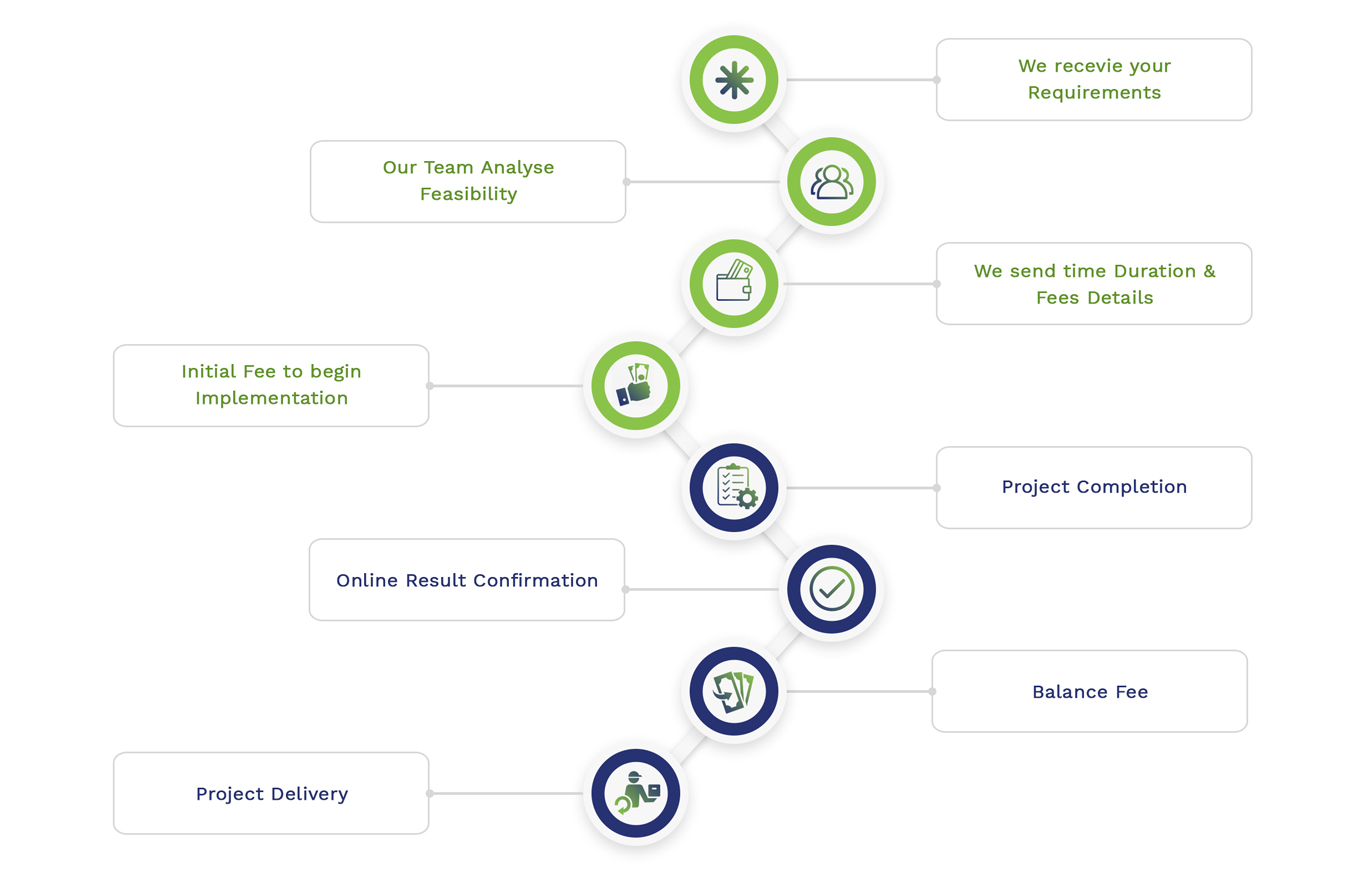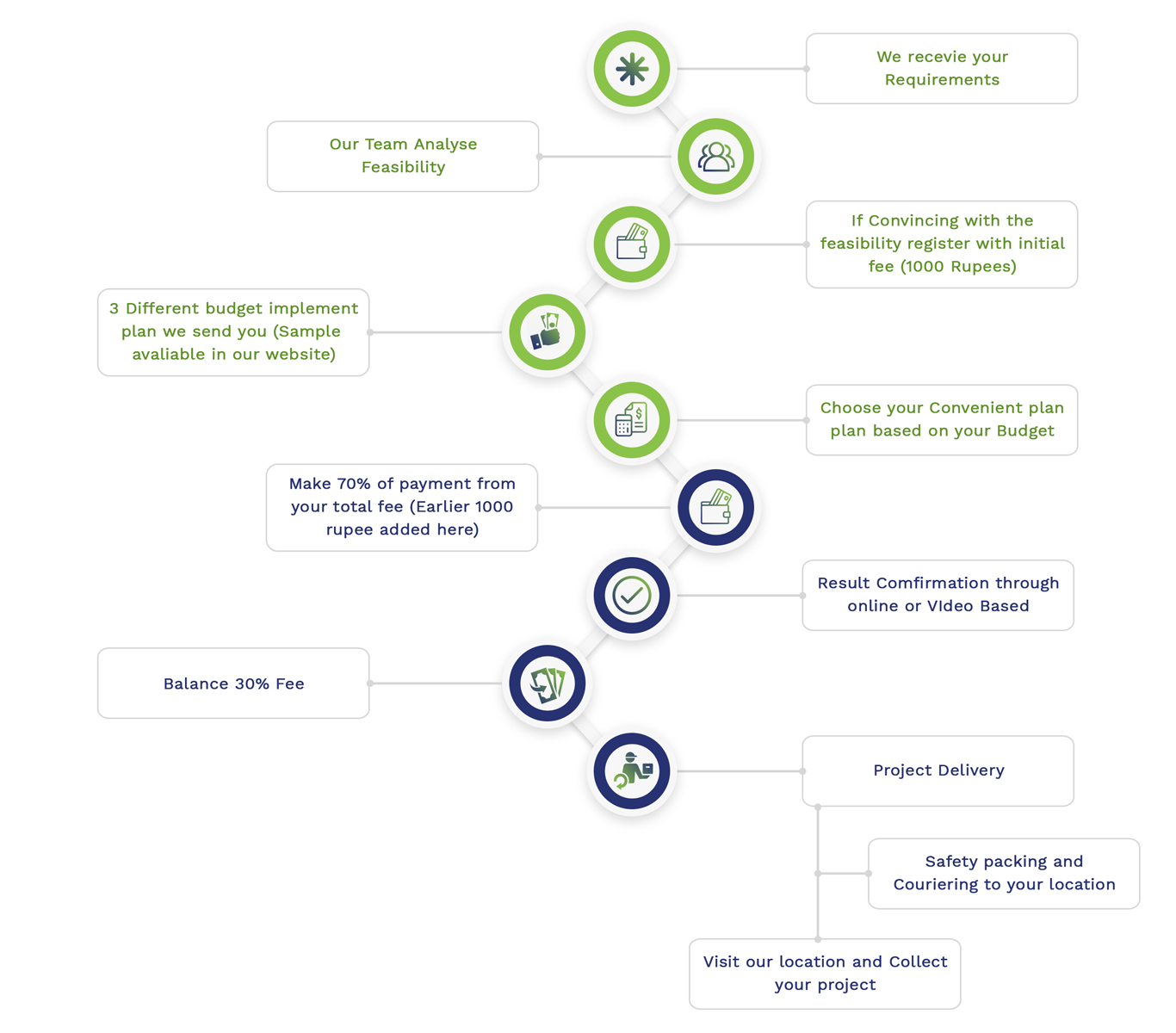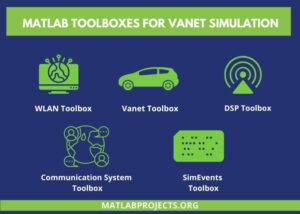Vehicular ad hoc networks or VANET is an evolving technology as it guarantees speedy and flawless connectivity amongst the vehicles and infrastructure. In the coming days vehicular to everything (or V2X) connectivity aims to share information across various stakeholders like cyclists, pedestrians, and automobiles by utilizing the cellular networks.
In this article let us look into the different aspects of VANET simulation in MATLAB.
Let us first start with the different types of vehicular communications,
TYPES OF VEHICULAR COMMUNICATIONS
The communication established among vehicles and the infrastructure at proximity can be classified under the following heads
- Vehicle to network
- Vehicle to infrastructure
- Vehicle-to-vehicle
- Vehicle to pedestrian
All these can be collectively called vehicles to everything communication. What are the characteristics of different types of vehicular communications?

- Increase the speed of communication
- Continuous and authentic data transfer
- Ensuring high safety in exchange of information among all (which includes infrastructure, pedestrians, vehicles, and cellular networks)
- A cooperative communication mechanism is used in VANET
- The mechanism of safety as given by Advanced Driver Assistance Systems are extended to VANET components
- It also provides video processing, RADAR, and LiDAR communications.
The objectives of various types of VANET designs mentioned above must be considered in a larger sense, which remains a research problem.
Our research professionals are available to assist you with this project. We’ve helped a lot of researchers to figure out how to establish themselves as experts in Vanet field. As a result, we will also provide you with guidance in the manner that you want100% successful output for Vanet Simulation in matlab. Now let us look into the important applications of VANET.
VANET APPLICATIONS
One of the major applications of VANET is establishing reliable and safe communication among vehicles and other infrastructures. Vehicle to infrastructure communication provides for the following safety aspects
- Curve speed and red light violation warning
- Warning to pedestrians in signalized crosswalks
- Reduction of speed, assistance for stop sign gap, and work zone warning
Another type of VANET system, that is a vehicle to vehicle communication provides for safety by avoiding crashes based on the following aspects,
- Forward Collision Warning (or FCW) and Left Turn Assist (or LTA)
- Emergency Electronic Brake Lights (or EEBL) and Do Not Pass Warning (or DNPW)
- Lane Change (or LCW) and Blind Spot Warning (or BSW)
- Intersection Movement Assist (IMA) and vehicle turning right in front of bus warning
There are many more potential applications of VANET that are being investigated by researchers around the world. We have been collecting huge research information regarding VANET to support you in your research career. So you can reach out to us for any kind of help. Now let us look into some general ideas needed for VANET Simulation in Matlab.
GENERAL IDEA OF VANET SIMULATION
During the planning stage, simulation has been utilized to provide a practical, cost-effective, convenient and adaptable environment for the system design. Simulation refers to a handy prototype that is transportable or the replica of whatever system is under consideration. The following are the major roles of simulation,
- Performance Analysis- provides for first-hand analysis on performance, throughput, and capacity
- Simulations – deeper analysis under different abstractions and on a large scale which can be conveniently shared and reproduced
- Testbeds- exact analysis on the performance at implementation (including constraints) is typically small scale networks
- Real-Time testing- expensive and highly realistic test which consume more time and efforts
In most cases, simulations and testbeds can be combined. To improve accuracy, we can use the MATLAB simulator for vanet based projects.Since MATLAB is being used in the context of smart (mobile) node distribution it also has a universal simulator to be used for a variety of purposes.
- The MATLAB simulation tool of 802.11p baseband transceiver called ubx – V2X is highly useful in V2X communications research.
- In this, all of the required transmission and reception processing blocks are defined as reference models.
- It also offers a number of thevehicle to vehicle channel model solutions
Generally, our developers identify research suggestions involving various simulation technologies and track them for further investigation. We have a lot of experience directing VANET Simulation in Matlab research initiatives. Contact our specialists if you have any questions. We’ll go through the specifics of the operational processes and give you recommendations on how to execute them successfully. Now let us look into the features of VANET.
MATLAB provides the following features for VANET
- A proper framework for multiple nodes and layers in network simulation is provided by MATLAB
- It provides support for designing, diagnosing, analyzing, and evaluating the performance of networks
- Simulation of network interference by various independent waveforms in a channel
- PHY and MAC components plug-in (various types)
- PHY waveform generator (LTE, 802.11, etc)
- Based on system objects and Stateflow (MAC)
- It also provides visualization tools for creating significant scenarios
- It can support in generating code for real-time execution
Researchers have been battling with so many issues relating to vehicular ad hoc networks. This has prompted our technical experts to begin compiling a data source of the various VANET research concerns linked with the characteristics stated above, as well as the methods used to develop ways to address them. Get in touch with us to know the solutions that we proposed
MAJOR COMPONENTS OF VANET SIMULATION
Simulation is a critical component of every project since it allows us to see if our idea can be implemented on a wide scale. Real-time project assessment can be a significant financial and technological challenge. As a result, a virtual environment provided by these simulation techniques may be a superior platform for testing our projects. Let us now look into the important components of VANET simulation in Matlab below,
- Behavior
- The behavior of humans and machines towards network traffic
- Modeling mobility
- Technology
- Infrastructure
- Devices of end-users
- Primary for modeling applications
- Environment
- Area information on train and location
- Propagation and interference
- Measurements
- Result of simulation
In VANET, the mobility modelling in simulation affects the procedures and throughput of a network along with the signal to noise and interference ratio. From the results obtained you can make improvements to your models. What kind of research support that we provide in MATLAB?
KEY FEATURES IN MATLAB
We have been using MATLAB since its initial phase of development. Using the different toolboxes in MATLAB, we have guided an ample number of successful research projects. So we have got huge experience in using it. Further, we are also specialists in the following aspects,
- Handling hybrid tools and complex snags
- Enthusiasm to guide innovation and make ideas into a successful reality
Since MATLAB supports all languages and libraries we also gained very much expertise in working with different programming languages. What are the programming languages supported by MATLAB? The following programming languages are supported by MATLAB,
- C, C + + and Java
- FORTRAN and python
- COM (Visual C#, .Net, VB.NET)
We are also experts in using these programming languages. In your project, you are free to choose any language you want. Our technical team is knowledgeable in a variety of languages. As a result, you can come to us for any type of assistance with any simulator or programming language. We will now give you a thorough understanding of the VANET simulation in MATLAB. MATLAB provides for the following in simulation of various aspects of VANET.
Key Features of VANET Simulation in MATLAB
- Visualization- various kinds of real-time networks and also complex networks that are quite different from them
- Process of design- time for calculation and designing the road situations is comparatively high
- Characteristics- defining the features have to be detailed
- Developing algorithm- you can develop complex algorithms using MATLAB
- Analysis of result- collecting and analyzing information is easy
These are the important VANET features from a technical perspective. Our professionals explain how the system works from the very beginning through the very end. You can get in touch with our team of engineers to get a full grasp of the stages involved in all of the Simulation tools. We will assist you in selecting the most appropriate Simulator for your Vanet project. Now let us understand how MATLAB features are useful in different VANET layers.
MATLAB FEATURES USES FOR VANET LAYERS
The following are the different features of MATLAB that can be used in various layers of vehicle ad hoc networks
- Components (static data)
- Payload, frame, and waveform entities
- Network data at different layers
- Messages – APP layer
- Waveform – PHY layer
- Frames – MAC layer
- Activities (drives entity)
- eventGenerate, eventDestroy, eventTimer and eventForward
- The following are the different activities associated with handling data
- Generating and destroying data
- Sending and receiving data among different layers
- Data timeout
- Actions (customized)
- payload generated, payloadTimer, payload entry, and payload exits
- The following actions are considered,
- Channel model – PHY layer
- Media access – MAC layer
- Routing algorithm – Network layer
We are here to provide you with a massive amount of research data and benchmark references for understanding this multiple-layered structure in VANET. Now let us look into how we model, visualize and simulate different VANET safety applications.
How to model, simulate and visualize VANET safety applications?
- The first step is to visualize and model the traffic scenarios and moving vehicles
- Equations of motion have to be utilized in order to predict and avoid Collision, handling vehicular manoeuvres and create algorithms for trajectory after Collision
- Simulation of IEEE 802.11p physical layer (V2V DSRC standard)
- Simultaneous simulation of IEEE MAC layer
We are here to provide you complete assistance on all aspects of modeling, simulation, and visualization of vehicular ad hoc networks for all safety applications. There are multiple simulation tools and techniques available for the simulation of vehicular ad hoc network projects. Before looking into detail about the simulation tools available let us first understand MATLAB toolboxes for VANET simulation better.
MATLAB TOOLBOXES FOR VANET SIMULATION
- WLAN toolbox
- VANET toolbox
- DSP toolbox
- Communication system toolbox
- SimEvents toolbox
The above mentioned are the prominent MATLAB Toolboxes used in VANET simulation.
- Users can manage simulations in batch using the VANET toolbox’s basic GUI
- Type ‘VANET’ in the Command Window to launch the GUI, then fine-tune the design criteria
- The simulink model is constrained in a huge simulation, and the GUI provides specific possibilities
Key Features of VANET Toolbox
The following are the prominent features of toolboxes in VANET
- Increase the accuracy in simulating the bit level PHY layer
- It can be extended to various tool boxes and SDR hardware
- Real-time traffic simulation is supported
- Multiple operating systems like Windows, OSX and LINUX are supported
- Capable of running simulations in groupings using the VANET toolbox’s basic GUI
- Type ‘vanet’ in the command window of MATLAB for launching the GUI and the essential parameters are adjusted
- VANET Library
- A vehicle object has been included in the VANET library, that comprises of the MAC, PHY and APP layers
- In addition, two vehicle blocks, control panel block and channel block should be included in order to replicate V2V communication
- Simulink demonstrations are also available
As mentioned earlier, VANET Toolbox is a Simulink framework that simulates vehicular networks. MAC layer, PHY layer, and APP layer are all included in the library.
- MAC layer
- According to IEEE 802.11p, the MAC layer used Enhanced Distributed Channel Access or EDCA
- The App layer’s messaging entity is transformed to a frames entity, which goes through a channel contention period before being transferred to the PHY layer as a waveform entity
- Waveform acquired from the PHY layer is transformed into payload and delivered to the APP layer
- Reliable Data Transmission or RDT also known as DATA – ACK is supported by MAC layer
- APP Layer
- Vehicular mobility models and message creation are handled by APP layer
- Messages like Lane changing Messages and Basic Safety Message are currently generated
- Lane changing model and car following model are the two mobility models that enable users to simulate lane changing and braking actions
- PHY Layer
- DSRC/WAVE standards based AWGN channel and two ray ground reflection model are included in the PHY layer
- WLAN system toolbox implements Rx/Tx and AWGN based on IEEE 802.11a
Usually, researchers approach us for advanced details on these toolboxes for complex system functioning Vanet Simulation in Matlab. We ensure complete assistance from a selection of project titles covering all aspects of research including project design, algorithm, and code writing and implementation. In this regard let us now see the methods of designing VANET systems using DES modules and other toolboxes
Architectural design of VANET toolboxes
The following are the construction of different layers in VANET functioning using simple DES modules
- APP layer
- Mobility model
- Car following model
- Lane changing model
- Generating APP message
- Emergency message
- Basic safety message
- Mobility model
- MAC layer
- MAC EDCA
- Broadcasting and multicasting
- Deferment of channel access
- Reliability in transmitting data
- PHY transmission
- psdu2waveform
- MAC EDCA
- PHY layer
- Wireless broadcasting
- PHY links
Constructing such a model with components mentioned above we are attempting to make a system driven by events and time. MAC (EDCA) and PHY (wireless channel links) layers are purely event and time-driven respectively.
So you can get all the requirements for VANET simulation in Matlab using the corresponding toolboxes in MATLAB. Let us now talk about the parameters for VANET simulation involved in MATLAB Simulink
MATLAB BASED VANET SIMULATION PARAMETERS
From the different elements of data (or parameters) associated with particular data frames, information on various properties like position, velocity, acceleration, and size of the network can be obtained. The following are such important simulation parameters involved in vehicular Ad-Hoc network Vanet simulation in MATLAB
- Information on velocity can be obtained from the elements of the Motion Data Frame given below
- Vertical, longitudinal, and lateral acceleration
- Speeding, yaw rate, and heading
- Transmission state and steering wheel angle
- Data on the size of the network is obtained from Vehicle Size Data Frame based on the following parameters
- Vehicle length
- Vehicle width
- Position information can be obtained from the Position Data Frame on the basis of the following elements
- Latitude and longitude
- Elevation and accuracy of position
- Acceleration data can be obtained from the following parameters in Motion Data Frame
- Status of brake applied, Anti-lock brake and auxiliary brake
- Status of stability and traction control
- Brake boost applied and unavailability of break status
All our projects have been designed in such a way to show maximum results on all the above parameters. The performance metrics also vary with applications. So get in touch with us for more tips from our experts on achieving maximum results in VANET simulation in Matlab. Now let us look into the technologies involved in the simulation of VANET projects.
VANET TOOLS FOR SIMULATION
- Cellular V2X device communication
- Dedicated short-range communications
These are the two major technologies involved in VANET simulation. It operates at 5.9 GHz band and uses Basic Safety Messages data exchange with the following performance essentials
- Latency less than 100-millisecond delay
- It supports huge velocities
- Its range is about 300 meters
Recent Trending VANET Research Areas?
- Interconnected vehicles
- Intelligent Vehicle technologies, infrastructure, and transport systems
- Data analytics, sustainable transport systems, and smart mobility
Apart from this, there are many other specific research topics related to VANET which have huge potential for future research. We guided the majority of the vehicle ad hoc network simulation projects. As a result, our professionals can assist you with any aspect of your study. We produced reports on the progress of the Vanet Simulation in Matlab projects for which we provided direction. For further information, contact our technical team.
Subscribe Our Youtube Channel
You can Watch all Subjects Matlab & Simulink latest Innovative Project Results
Our services
We want to support Uncompromise Matlab service for all your Requirements Our Reseachers and Technical team keep update the technology for all subjects ,We assure We Meet out Your Needs.
Our Services
- Matlab Research Paper Help
- Matlab assignment help
- Matlab Project Help
- Matlab Homework Help
- Simulink assignment help
- Simulink Project Help
- Simulink Homework Help
- Matlab Research Paper Help
- NS3 Research Paper Help
- Omnet++ Research Paper Help
Our Benefits
- Customised Matlab Assignments
- Global Assignment Knowledge
- Best Assignment Writers
- Certified Matlab Trainers
- Experienced Matlab Developers
- Over 400k+ Satisfied Students
- Ontime support
- Best Price Guarantee
- Plagiarism Free Work
- Correct Citations
Expert Matlab services just 1-click

Delivery Materials
Unlimited support we offer you
For better understanding purpose we provide following Materials for all Kind of Research & Assignment & Homework service.
 Programs
Programs Designs
Designs Simulations
Simulations Results
Results Graphs
Graphs Result snapshot
Result snapshot Video Tutorial
Video Tutorial Instructions Profile
Instructions Profile  Sofware Install Guide
Sofware Install Guide Execution Guidance
Execution Guidance  Explanations
Explanations Implement Plan
Implement Plan
Matlab Projects
Matlab projects innovators has laid our steps in all dimension related to math works.Our concern support matlab projects for more than 10 years.Many Research scholars are benefited by our matlab projects service.We are trusted institution who supplies matlab projects for many universities and colleges.
Reasons to choose Matlab Projects .org???
Our Service are widely utilized by Research centers.More than 5000+ Projects & Thesis has been provided by us to Students & Research Scholars. All current mathworks software versions are being updated by us.
Our concern has provided the required solution for all the above mention technical problems required by clients with best Customer Support.
- Novel Idea
- Ontime Delivery
- Best Prices
- Unique Work
Simulation Projects Workflow

Embedded Projects Workflow



 Matlab
Matlab Simulink
Simulink NS3
NS3 OMNET++
OMNET++ COOJA
COOJA CONTIKI OS
CONTIKI OS NS2
NS2







